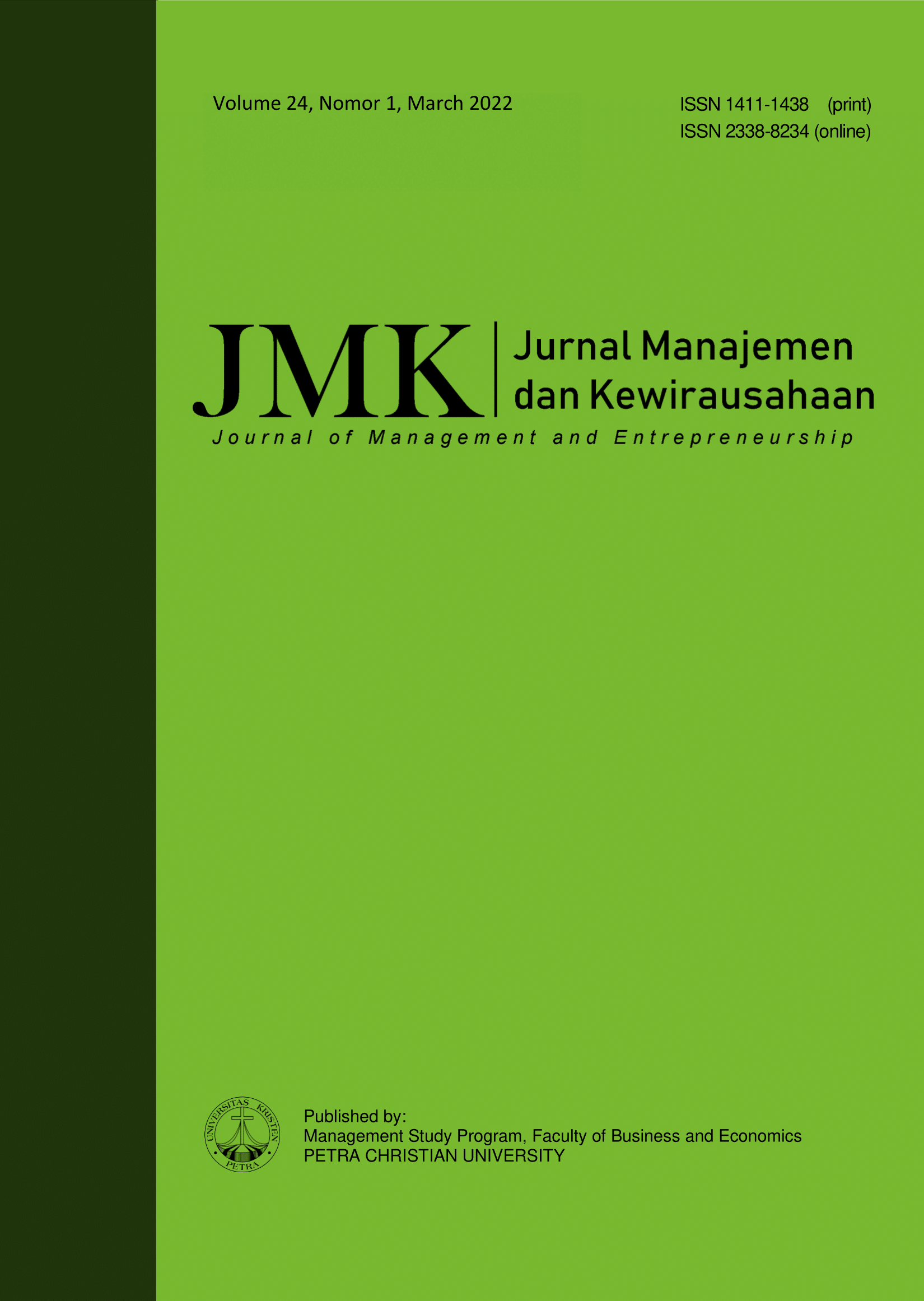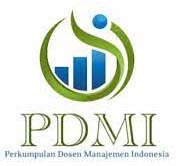THE ROLE OF COMPETENCIES, FINANCIAL PLANNING, AND ACCESS TO FINANCE IN EXPLAINING SMEs FINANCIAL INNOVATION
 :
:
https://doi.org/10.9744/jmk.24.1.44-51
Keywords:
Competencies, financial innovation, access to finance, financial planningAbstract
Finance was a crucial aspect for the survival of SMEs. This study explored the factors that can influence financial innovation. Data was collected from the results of distributing questionnaires to 285 SMEs using a door-to-door approach and filling assistance. Sampling was based on the proportion of small and medium-sized industries. The data were tested with a series of statistical tests to obtain a suitable regression result. These results indicated that financial innovation was influenced by the owner or manager's entrepreneurial competence. Meanwhile, access to finance and financial planning did not affect financial innovation. Additional funds from outside the company were deemed necessary when the owner or manager of SMEs applies their maximum competence for business growth and performance. Therefore, it forced SMEs to be smart in exploring financial sources. SMEs tent to use their finance access to finance their business operations rather than making financial innovations. SMEs did not think about exploring their finances anymore because they feelt they had enough loans obtained from one institution. Even though the knowledge of SME owner or manager financial planning was quite good; they prefered not to make financial planning and let the cash flow normally.
References
Adomako, S., Danso, A., & Damoah, J. O. (2015). The moderating influence of financial literacy on the relationship between access to finance and firm growth in Ghana. Venture Capital, 18(1), 43–61. https://doi.org/10.1080/13691066.2015.1079952
Ahiawodzi, A. K., & Adade, T. C. (2012). Access to credit and growth of small and medium scale en-terprise in the ho municipality of Ghana. British Journal of Economics, Finance and Management Sciences, 6(2), 34–51.
Akkaya, M. (2019). Financial innovation: Theories, models, and future. In H. Din¬çer, & S. Yüksel (Eds.), Handbook of research on managerial thinking in global business economics (pp. 115–139). IGI Global. https://doi.org/10.4018/978-1-5225-7180-3.ch007
Alosani, M. S., Yusoff, R., & Al-Dhaafri, H. (2020). The effect of innovation and strategic planning on enhancing organizational performance of Dubai Police. Innovation & Management Review, 17 (1), 2–24. https://doi.org/10.1108/INMR-06-20 18-0039
Angilella, S., & Mazzù, S. (2015). The financing of innovative SMEs: A multicriteria credit rating model. European Journal of Operational Research, 244(2), 540–554. https://doi.org/https://doi. org/10.1016/j.ejor.2015.01.033
Bandopadhyaya, A., Callahan, K., & Shin, Y.-C. (2012). Corporate financial strategy. In Financial Services Forum Publications.
Beck, T., Chen, T., Lin, C., & Song, F. M. (2016). Financial innovation: The bright and the dark sides. Journal of Banking & Finance, 72(November), 28–51. https://doi.org/10.1016/j.jbankfin.20 16.06.012
Boon, T. H., Yee, H. S., & Ting, H. W. (2011). Financial literacy and personal financial planning in Klang Valley, Malaysia. International Journal of Economics and Management, 5(1), 149–168.
Bottazzi, G., Secchi, A., & Tamagni, F. (2014). Finan-cial constraints and firm dynamics. Small Busi-ness Economics, 42 (1), 99–116. https://doi.org/10.1007/s11187-012-9465-5
BPS Jepara. (2019). Tabel dinamis banyaknya unit usaha dan tenaga kerja dirinci. Retrieved from https://jeparakab.bps.go. id/
Cao, S., & Leung, D. (2016). Financial constraint and productivity: Evidence from Canadian SMEs. In Bank of Canada Staff Working Paper.
Chatterjee, S., & Goetz, J. W. (2019). Applications of Behavioral economics in personal financial planning. In C. R. Chaffin (Ed.), Financial planning competency handbook (Second, pp. 751–762). John Wiley & Sons, Inc. https://doi.org/10.1002/9781119642497.ch82
Dunk, A. S. (2011). Product innovation, budgetary control, and the financial performance of firms. British Accounting Review, 43(2), 102–111. https://doi.org/10.1016/j.bar.2011.02.004
Eniola, A. A., & Entebang, H. (2015). SME firm performance financial innovation and challenges. Procedia - Social and Behavioral Sciences, 195, 334–342. https://doi.org/10.1016/j.sbspro.2015. 06.361
Fowowe, B. (2017). Access to finance and firm performance: Evidence from African countries. Review of Development Finance, 7(1), 6–17. https: //doi.org/10.1016/j.rdf.2017.01.006
Harash, E., Al-timimi, S., & Alsaadi, J. (2014). The influence of finance on performance of small and medium enterprises (SMEs). International Journal of Engineering and Innovative Technology, 4 (3), 161–167.
Hemer, J. (2011). A snapshot on crowdfunding. In Working papers firms and region.
Hunter, S. T., Cassidy, S. E., & Ligon, G. S. (2012). Planning for innovation: A process oriented perspective. In M. D. Mumford (Ed.), Handbook of organizational creativity (pp. 515–545). Academic Press. https://doi.org/10.1016/B978-0-12-374714-3.00020-3
Ikasari, N., Sumransat, T., Eko, U., & Kusumastuti, R. (2016). Access of small and medium enterprises to finance in rural areas: Case of Indonesia and Thailand. International Journal of Economics and Management Engineering, 10(5), 1661–1668.
Ismanto, H., Muharam, H., Rini, I., Pangestuti, D., Widiastuti, A., & Rofiq, F. (2019). The nexus between financial literacy and the credit status in Indonesia. Financial Studies, 23(3), 49–65.
Kabue, L. W., & Kilika, J. M. (2016). Firm resources, core competencies and sustainable competitive advantage: An integrative theoretical framework. Journal of Management and Strategy, 7(1), 98–108. https://doi.org/10.5430/jms.v7n1p98
Lee, N., Sameen, H., & Martin, L. (2013). Credit and the crisis: Access to finance for innovative small firms since the recession (Issue June). Big Innovation Center.
Li, K., Niskanen, J., Kolehmainen, M., & Niskanen, M. (2016). Financial innovation: Credit default hybrid model for SME lending. Expert Systems with Applications, 61(November), 343–355. https://doi.org/10.1016/j.eswa.2016.05.029
Man, T. W. Y., Lau, T., & Snape, E. (2008). Entrepreneurial competencies and the performance of small and medium enterprises: An investigation through a framework of competitiveness. Journal of Small Business and Entrepreneurship, 21(3), 257–276. https://doi.org/10.1080/08276331.2008. 10593424
McDermott, C. M., & Prajogo, D. I. (2012). Service innovation and performance in SMEs. International Journal of Operations and Production Management, 32 (2), 216–237. https://doi.org/10.1108/01443571211208632
Racela, O. C. (2014). Customer orientation, innovation competencies, and firm performance: A proposed conceptual model. Procedia - Social and Behavioral Sciences, 148, 16–23. https://doi.org/10.1016/j.sbspro.2014.07.010
Sánchez, J. (2012). The influence of entrepreneurial competencies on small firm performance. Revista Latinoamericana de Psicologia, 44(2), 165–177.
Sarwoko, E., Surachman, Armanu, & Hadidjojo, D. (2013). Entrepreneurial characteristics and competency as determinants of business performance in SMEs. IOSR Journal of Business and Management, 7(3), 31–38. https://doi.org/10.9790/487x-0733138
Sebestova, J., & Rylkova, Z. (2011). Competencies and innovation within learning oranization. Economic and Management, 16, 954–961.
Tahir, S. H., Shah, S., Arif, F., Ahmad, G., Aziz, Q., & Ullah, M. R. (2018). Does financial innovation
improve performance? An analysis of process innovation used in Pakistan. Journal of Innovation Economics Management, 3(27), 195–214. https://doi.org/10.3917/jie.027.019 5
Tehseen, S., & Ramayah, T. (2015). Entrepreneurial competencies and SMEs business success: The contingent role of external integration. Mediterranean Journal of Social Sciences, 6(1), 50–61. https://doi. org/10.5901/mjss.2015.v6n1p50
Veliu, L., & Manxhari, M. (2017). The impact of managerial competencies on business perfor-mance: SME’s in Kosovo. Journal of Mana-gement, 30(1), 59–65.
Verstina, N. G., Akimova, E. M., Kisel, T. N., Chibi-sova, E. Y., & Lukinov, V. A. (2015). Financial planning at small construction enterprises at the formation stage. International Journal of Economics and Financial Issues, 5(3), 217–223.
Vila, L. E., Prez, P. J., & Coll-Serrano, V. (2014). Innovation at the workplace: Do professional competencies matter? Journal of Business Re-search, 67(5), 752–757. https://doi.org/10.1016/j.jbusres.20 13.11.039
Wonglimpiyarat, J. (2011). The dynamics of financial innovation system. Journal of High Technology Management Research, 22(1), 36–46. https://doi.org/10.1016/j.hitech.2011.03.003
Zarutskie, R. (2013). Competition, financial innovation and commercial bank loan portfolios. Journal of Financial Intermediation, 22(3), 373–396. https://doi.org/10.1016/j.jfi.2013.02.001
Downloads
Published
How to Cite
Issue
Section
License
Authors who publish on this journal agree to the following terms:
- Authors retain copyright and grant the journal right of first publication with the work simultaneously licensed under a Creative Commons Attribution License that allows others to share the work with an acknowledgement of the work's authorship and initial publication in this journal.
- Authors are able to enter into separate, additional contractual arrangements for the non-exclusive distribution of the journal's published version of the work (e.g., post it to an institutional repository or publish it in a book), with an acknowledgement of its initial publication in this journal.
- Authors are permitted and encouraged to post their work online (e.g., in institutional repositories or on their website) prior to and during the submission process, as it can lead to productive exchanges, as well as earlier and greater citation of published work (See The Effect of Open Access).


















